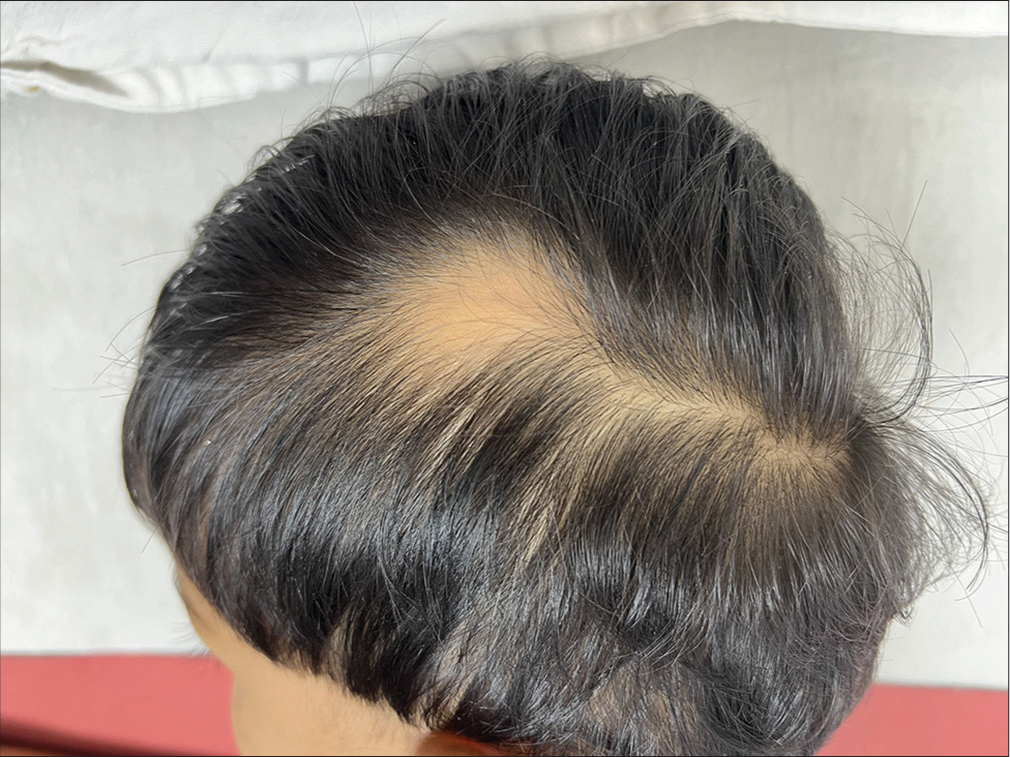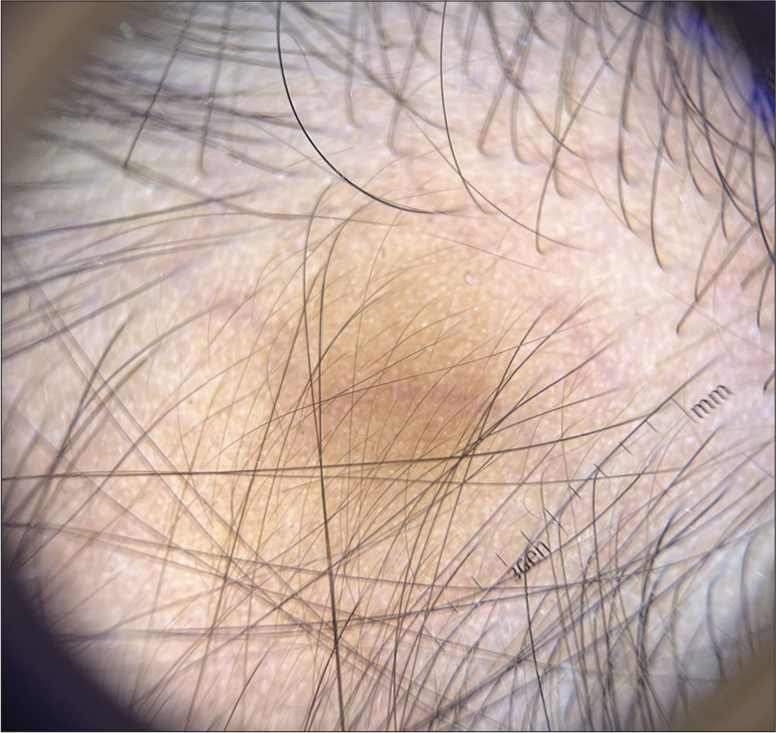Translate this page into:
A case of congenital extratemporal non-triangular alopecia of the scalp: Need to revisit the conventional terminology

*Corresponding author: Dr. Keshavmurthy A. Adya, Department of Dermatology, Venereology, and Leprosy, Shri B. M. Patil Medical College Hospital and Research Centre, BLDE (Deemed to be University), Vijayapur, Karnataka, India. adya.murthy@gmail.com
-
Received: ,
Accepted: ,
How to cite this article: Adya KA, Inamadar AC. A case of congenital extratemporal non-triangular alopecia of the scalp: Need to revisit the conventional terminology. CosmoDerma. 2025;5:1. doi: 10.25259/CSDM_196_2024
Dear Sir,
A 3-year-old girl was brought to us with a congenital non-progressive hairless patch on her scalp. Examination revealed a circular non-scarring alopecic patch measuring about 2 × 2 cm on the left fronto-parietal region [Figure 1]. Trichoscopy exhibited a monomorphic pattern of vellus hairs occupying the entire alopecic area. The vellus hairs showed varying lengths with reduced follicular density [Figure 2]. The clinical and trichoscopic findings were diagnostic of temporal triangular alopecia and the absence of trichoscopic features such as black dots, yellow dots, empty follicles, and exclamation mark hairs effectively ruled out alopecia areata which is also an acquired disorder.[1-3]

- A circular non-scarring alopecic patch of about 2 × 2 cm involving the left fronto-parietal region.

- Trichoscopy (using DermLite™ DL3, San Juan Capistrano, CA, USA) showing a monomorphic pattern of vellus hairs of different lengths and reduced follicular density (Polarized mode, ×10).
This report intends to highlight that although frequent, temporal triangular alopecia may not always be “temporal” in location or “triangular” in shape. Involvement of areas of the scalp other than the temporal or fronto-temporal region, unilaterally and/or bilaterally, has also been described and the shape of the patches may also be oval, lanceolate, or, as in the index case, circular resembling alopecia areata.[4] Furthermore, the involvement of hair-bearing areas other than the scalp has also been described.[5] It may hence be well advised to prefer “congenital localized alopecia” rather than terminologies such as temporal triangular or congenital triangular alopecia used conventionally. As this report also depicts, the role of trichoscopy in this condition as a non-invasive diagnostic tool as well as in differentiating from alopecia areata cannot be overemphasized.
Ethical approval
Institutional Review Board approval is not required.
Declaration of patient consent
The authors certify that they have obtained all appropriate patient consent.
Conflicts of interest
There are no conflicts of interest.
Use of artificial intelligence (AI)-assisted technology for manuscript preparation
The authors confirm that there was no use of artificial intelligence (AI)-assisted technology for assisting in the writing or editing of the manuscript and no images were manipulated using AI.
Financial support and sponsorship
Nil.
References
- Trichoscopy: A useful tool in diagnosing temporal triangular alopecia. Indian J Postgrad Dermatol 2024 Doi: 10.25259/IJPGD_32_2024
- [CrossRef] [Google Scholar]
- Use of dermoscopy in the diagnosis of temporal triangular alopecia. An Bras Dermatol. 2015;90:123-5.
- [CrossRef] [PubMed] [Google Scholar]
- Congenital triangular alopecia. Int J Trichology. 2015;7:48-53.
- [CrossRef] [PubMed] [Google Scholar]
- Congenital triangular alopecia. BMJ Case Rep. 2014;2014:bcr2013202918.
- [CrossRef] [PubMed] [Google Scholar]
- Congenital symmetrical circumscribed patterned non-scarring alopecia of eyebrows: A variant of congenital triangular alopecia or an anatomical variation? BMJ Case Rep. 2019;12:e227472.
- [CrossRef] [PubMed] [Google Scholar]





